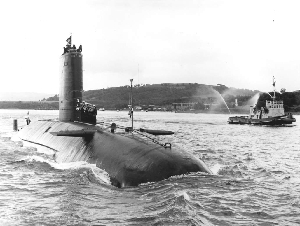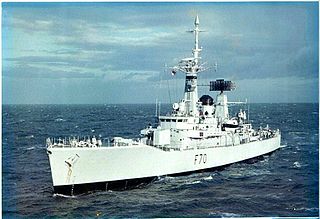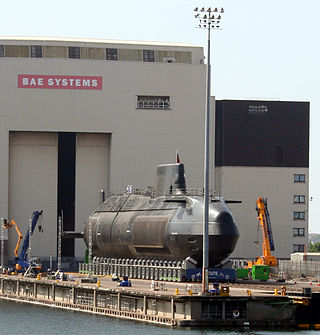Design
The Churchills carried a crew of 103 and had a full load displacement of 4,900 tons whilst dived. They were 86.9 metres (285 ft 1 in) long, had a beam of 10.1 metres (33 ft 2 in) and a draught of 8.2 metres (26 ft 11 in). Their single pressurized water-cooled reactor supplied steam to two English Electric geared turbines, producing a total of 20,000 shaft horsepower (15,000 kW ) for the single shaft and resulting in a maximum of 28 knots (52 km/h) submerged. Like all nuclear-powered submarines the Churchill class could remain submerged almost indefinitely, with supplies of food being the only limiting factor. One Kelvin Type 1006 surface-search radar was fitted. The ships were built with a Type 2001 sonar array, but this was replaced in the late 1970s with a Type 2020 array and a Type 2026 towed array. Weapons included Mk VIII torpedoes, Mk 24 Tigerfish torpedoes, and Sub-Harpoon anti-ship missiles. Six 21-inch (533 mm) torpedo tubes fired from the bow.
HMS Churchill evaluated both the American Mark 48 torpedo and the UGM-84 Harpoon missile, though only the latter was adopted by the Royal Navy. She was decommissioned in 1990 and is laid up at Rosyth awaiting disposal.
In 1981 HMS Courageous became the first British submarine to carry the Sub-Harpoon missile. She was decommissioned in 1992 and is at Devonport Dockyard serving as a museum ship.

The Resolution class was a class of four nuclear ballistic missile submarines (SSBN) built for the Royal Navy as part of the UK Polaris programme. Each submarine was armed with up to 16 UGM-27 Polaris A-3 nuclear missiles.

The Swiftsure class was a class of nuclear-powered fleet submarines in service with the Royal Navy from the early 1970s until 2010.

ARAGeneral Belgrano (C-4) was an Argentine Navy light cruiser in service from 1951 until 1982. Originally commissioned by the U.S. Navy as USS Phoenix, she saw action in the Pacific theatre of World War II before being sold to Argentina. The vessel was the second to have been named after the Argentine founding father Manuel Belgrano (1770–1820). The first vessel was a 7,069-ton armoured cruiser completed in 1896.

The Type 23 frigate or Duke class is a class of frigates built for the United Kingdom's Royal Navy. The ships are named after British Dukes, thus leading to the class being commonly known as the Duke class. The first Type 23, HMS Norfolk, was commissioned in 1989, and the sixteenth, HMS St Albans was commissioned in June 2002. They form the core of the Royal Navy's destroyer and frigate fleet and serve alongside the Type 45 destroyers. They were designed for anti-submarine warfare, but have been used for a range of uses. Ten Type 23 frigates remain in service with the Royal Navy, with three vessels having been sold to the Chilean Navy, and one being retired in 2021, and two being retired in 2023.

HMS Splendid was a Royal Navy nuclear-powered fleet submarine of the Swiftsure class. From commissioning in 1979 to her decommission in 2004 she took part in many operations involving British forces around the globe.

HMS Conqueror was a British Churchill-class nuclear-powered fleet submarine which served in the Royal Navy from 1971 to 1990. She was the third submarine of her class, following the earlier Churchill and Courageous, that were all designed to face the Soviet threat at sea. She was built by Cammell Laird at Birkenhead.

The County class was a class of British guided missile destroyers, the first such warships built by the Royal Navy. Designed specifically around the Seaslug anti-aircraft missile system, the primary role of these ships was area air defence around the aircraft carrier task force in the nuclear-war environment.

The Type 21 frigate, or Amazon-class frigate, was a British Royal Navy general-purpose escort that was designed in the late 1960s, built in the 1970s and served throughout the 1980s into the 1990s.

HMS Glamorgan was a County-class destroyer of the Royal Navy with a displacement of 5,440 tonnes. The ship was built by Vickers-Armstrongs in Newcastle Upon Tyne and named after the Welsh county of Glamorgan.

The Type 14 Blackwood class were a ship class of minimal "second-rate" anti-submarine warfare frigates. Built for the Royal Navy during the 1950s at a time of increasing threat from the Soviet Union's submarine fleet, they served until the late 1970s. Twelve ships of this class served with the Royal Navy and a further three were built for the Indian Navy.

The Leander-class, or Type 12I (Improved) frigates, comprising twenty-six vessels, was among the most numerous and long-lived classes of frigate in the Royal Navy's modern history. The class was built in three batches between 1959 and 1973. It had an unusually high public profile, due to the popular BBC television drama series Warship. The Leander silhouette became synonymous with the Royal Navy through the 1960s until the 1980s.

The Valiant class were a class of nuclear-powered fleet submarines in service with the Royal Navy from the mid-1960s until 1994. They were the first fully British nuclear fleet submarine; the earlier HMS Dreadnought used an American nuclear reactor. There were only two boats in the class, the first, Valiant commissioned in 1966 three years after Dreadnought, and Warspite the following year. Both were built by Vickers at Barrow-in-Furness.

A nuclear submarine is a submarine powered by a nuclear reactor, but not necessarily nuclear-armed. Nuclear submarines have considerable performance advantages over "conventional" submarines. Nuclear propulsion, being completely independent of air, frees the submarine from the need to surface frequently, as is necessary for conventional submarines. The large amount of power generated by a nuclear reactor allows nuclear submarines to operate at high speed for long periods, and the long interval between refuelings grants a range virtually unlimited, making the only limits on voyage times being imposed by such factors as the need to restock food or other consumables.

An SSN is a nuclear-powered general-purpose attack submarine. SSN is the US Navy hull classification symbol for such vessels; the SS denotes a submarine and the N denotes nuclear power. The designation SSN is used for interoperability throughout NATO under STANAG 1166, though navies use other terms.

The Rothesay class, or Type 12M frigates were a class of frigates serving with the Royal Navy, South African Navy and the Royal New Zealand Navy.

The Royal Navy Submarine Service is one of the five fighting arms of the Royal Navy. It is sometimes known as the Silent Service, as submarines are generally required to operate undetected.

HMS Courageous (S50) is a decommissioned Churchill-class nuclear fleet submarine in service with the Royal Navy from 1971. She is now a museum ship managed by the Devonport Naval Heritage Centre.

An exchange on 24 May 1983 between Diana Gould, an English schoolteacher and former Women's Royal Naval Service meteorological officer, and British prime minister Margaret Thatcher was voted in 1999 as one of Britain's most memorable television spots. Appearing as a member of the public on BBC Nationwide's On the Spot live election special, Gould confronted Thatcher over the sinking of the Belgrano, an Argentine warship, during the 1982 Falklands War between the United Kingdom and Argentina.


















